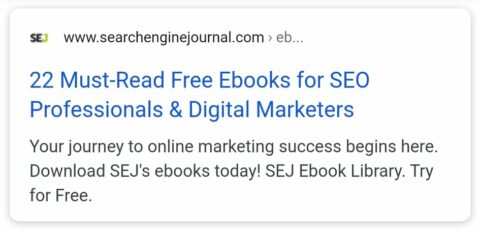Do meta descriptions still matter in SEO?
Yes. But maybe not for the reasons you initially think of.
Because you still need meta descriptions, there are some best practices you need to follow when creating them.
We can assuredly say meta descriptions are not a crucial factor in where your content will rank in Google, but if Bing is a focus for you, they do support and give them more weight.
Regardless, we all know SEO is not just about rank.
Search engine optimization is also about:
- Establishing authority.
- Attracting eyeballs.
- Engaging with a target audience via keyword-rich content.
- Inducing some action by searchers.
Meta descriptions still very much matter as they make up and/or contribute to a significant portion of content displayed in the search engine results.
When you look at a search result, what do you see?
A URL, a clickable page title in blue, and a snippet of text (sometimes the meta description you’ve created), which hopefully provides some explanation of what you will see if/when you click.

Meta descriptions still represent an opportunity for site owners to “promote” a page and/or incorporate a call to action directly into the search results.
A meta description may include a call to action to “Click to learn/read/discover more!” or “Click to buy now!”
If you manage the website of a local business you may want to instruct your users to “Call today at xxx-xxx-xxxx…”
This can be a particularly effective strategy as the number of mobile searches continues to climb.
If someone searching on a phone sees a list of search results and yours is the only one which includes a number they can quickly call without having to search further, you have naturally increased your chances of getting the call.
According to a recent study, Google is choosing to rewrite and replace meta descriptions upwards of 70% of the time on results displayed on mobile devices and by a slightly lesser percentage on desktops.
However, these snippets of content generated by site owners, by Google’s own admission, are a great way to provide a summary of what a webpage is all about.
And then Google can and will decide what they want to do with this info.
30% of the time, they will use what you’ve created, so it simply makes sense to create the best meta descriptions you can.
Mistake 1: Meta Descriptions Which Are Too Long
There is only so much room for a search result, particularly on a mobile device.
The general rule of thumb for maximum meta description length is 160 characters for desktop and 120 for mobile.


It is interesting to note that Google tends to give themselves a bit more leeway on characters when they are authoring descriptions.
So, even if you have the most ideal page summary ever written, Google is going to truncate it and, more likely, rewrite it altogether if it is beyond these limits.
Concise and clear, yet engaging meta descriptions are key.
Hey, no one said this stuff is easy.
Mistake 2: Meta Descriptions Which Are Too Short
While brevity is important, it stands to reason you should still make the most of the room allotted to summarize and promote your content.
Chances are that search engines will view short meta descriptions as lacking in substance and therefore quality.
This can both potentially hurt your ability to have the page rank and most certainly have the description replaced with content of Google’s choosing.
With only 160 characters or less to play with and a call to action to incorporate, there should really be no reason for this to happen.
Mistake 3: Meta Description Is Inconsistent with Page Content
Meta descriptions are meant to summarize the page they are associated with.
Yet there are ample instances, whether due to laziness or a lack of attention to detail, where they do not accurately reflect what’s on the page.
In this case, not only will your meta description not be used by the search engine, it may also do harm to your chances of having your content properly indexed and ranked.
Mistake 4: A Lack of Relevant Keywords
Think of the meta description as a place to expand upon your webpage title. If you had the ability to write a longer title (which is even more restrictive than the meta description character-wise), which keywords would you use?
Make sure you incorporate enough relevant and topically related keywords to signal to the search engines and your target audience the description is in truly in line with the content on the page it describes. Google will sometimes highlight the keywords it deems particularly relevant, which only further increases your chance of having your content noticed and engaged with in the SERPs.
Mistake 5: Description Duplication
Duplicate meta descriptions appearing on multiple website pages is commonly the result of website owner laziness or corner cutting.
We all know duplicate content is a frowned upon by the search engines and this is likewise true when it comes to descriptions. Each page must have its own unique, engaging description, otherwise the search engine crawlers may very well pass it by, along with the content it’s describing.
Sometimes meta descriptions are auto-generated by a CMS or plugin and then overlooked or disregarded. However, many plugins also make recommendations to fix them. If this all sounds familiar, take the time to review and optimize based on those suggestions.
Mistake 6: Keyword Stuffing
Stuffing the same or very similar keywords into webpage content is an understood SEO no-no and the same goes for meta descriptions.
It is good to incorporate a primary keyword or phrase into your page description for consistency with your page title and potentially your URL (which Google will often highlight in the search result).
But it is not advisable and will be obvious if you have multiple variations of the same keyword crammed into a 160-character sentence.
This will likely have the same rank debilitating effect as non-aligned or duplicate descriptions.
Mistake 7: Your Meta Description Is Boring
As noted, meta descriptions have a dual role of describing a webpage and engaging your desired audience via the search engine results.
Simply put, do not create boring meta descriptions searchers will immediately glance over.
Give them a reason to stop, read and maybe even click to learn more.

I wonder what water-cooled chillers use in the chilling process?
Water?
You don’t say.
Don’t just tell me what it is. Tell me why I need it and how I can buy it.
And please don’t be boring.
And which is the more compelling of these two examples, which are displayed next to each other in a SERP for “iPhone cases”?
I know which one I would visit and more likely tend to buy from.


Mistake 8: Leaving Out a Call to Action
If you are able to fully describe the content and context of your page and still have room to add a call to action, you should.
A nudge to your prospect/customer may be enough to get them to click on your link instead of your competitors’ which may lack the same prompt.

There is an underlying psychology to using calls to action whereby you focus your consumer on benefits, minimize their risk, and/or create a sense of urgency.
Who wouldn’t want to “Click now for a free, no-obligation offer!”?
Having searchers click on your result is a way of demonstrating your authority and can result in improved positioning in the search results.
So why not use every means possible to improve your chances of receiving clicks?
Mistake 9: Confusing ‘Meta Descriptions’ with ‘Snippets’
Meta descriptions (the words you write) and snippets (the words the search engines display in the SERPs) are not the same thing.
As noted above, Google may only use your meta description around 30% of the time.
You will want to be sure both your meta description and the rest of your page content are optimized for the topical, intent-based keyword groups you are hoping to be found for.
Even if the search engine doesn’t use your description, it may still influence the final snippet displayed.
There are many snippet types and best practices for creating and optimizing your content with featured snippets in mind.
Mistake 10: Not Writing Your Meta Descriptions at All

By now, this point should not have to be made, but a quick review of many websites will reveal a basic lack of meta descriptions.
Perhaps you’ve heard and believed (before reading this) that meta descriptions don’t matter at all and shouldn’t be prioritized.
Below is an example of what can happen when you have no description, limited content and Google has to decide what’s left to put there.
In this case, they just grabbed the navigation, which provides little to no value or reason to click.

Hopefully, you’ve been convinced meta descriptions do play an important role in improving the visibility and click-through potential of your website content in the search engines.
Summary
Meta descriptions do still matter.
They play an important role in helping you both improve your organic search visibility and receive more targeted website traffic.
As with all things SEO, there are some simple best practices you can follow to maximize their effectiveness.
A little attention to detail can go a long way and maybe steal a few eyeballs away from all the rest of the noise.
More Resources:





